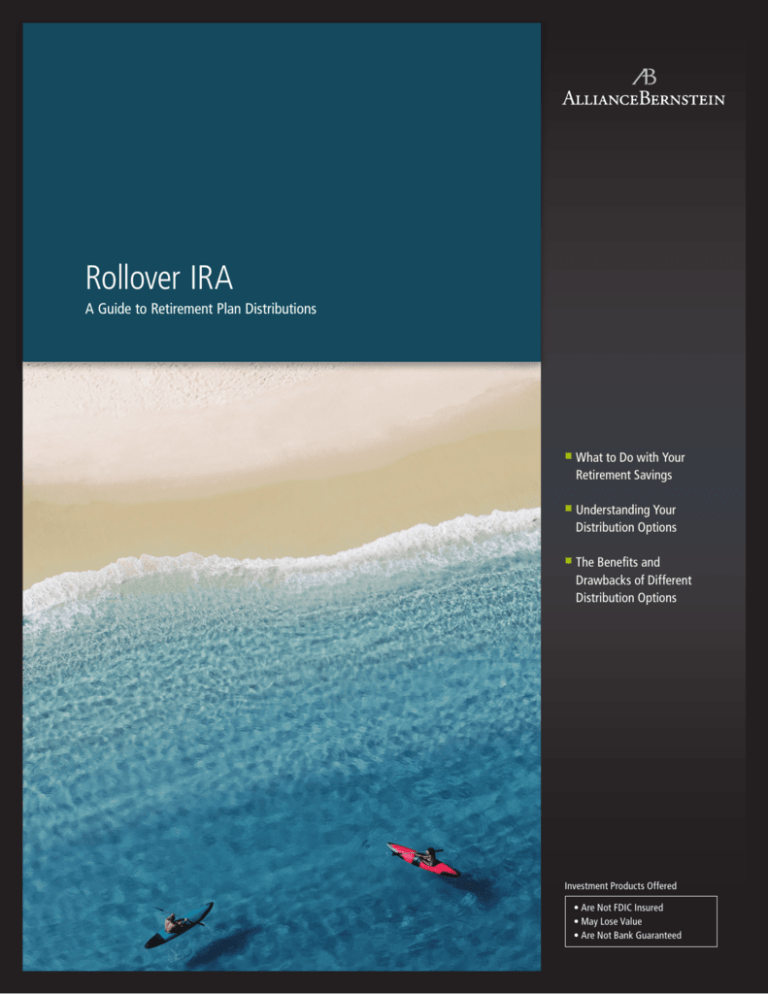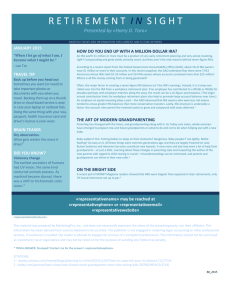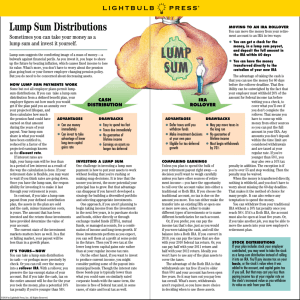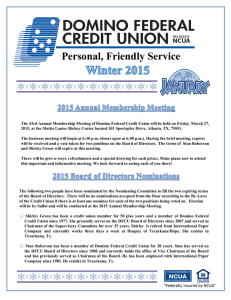Rollover IRA - AllianceBernstein L.P.
advertisement

Rollover IRA A Guide to Retirement Plan Distributions What to Do with Your Retirement Savings Understanding Your Distribution Options The Benefits and Drawbacks of Different Distribution Options Investment Products Offered • Are Not FDIC Insured • May Lose Value • Are Not Bank Guaranteed A Guide for What to Do with Your Retirement Savings As you retire or change jobs, or if you just have money in a former employer’s retirement plan, one of the most important decisions you have to make is what to do with the money you’ve saved for retirement. Changing Jobs? Retiring? What Is a Lump-Sum Distribution? Any big change in life can be stressful. Changing jobs and retiring are no exception. Although this can be an exciting time in your life, it’s also the time to focus on deciding what to do with your retirement plan account. Should you roll over your money to an Individual Retirement Account (IRA)? Should you take a cash distribution? This guide can assist you in making a confident decision about what to do with your retirement nest egg. A lump-sum distribution is a payout of all the money you’ve accumulated in your retirement plan account. Most people receive a lump-sum distribution from an employer-sponsored retirement plan, such as a 401(k), 403(b), 457 or profit-sharing plan, when changing jobs or retiring. You’ll often see the terms “lump-sum distribution” and “retirement plan distribution” used interchangeably. What Should You Do with Your Lump-Sum Distribution? The decision you make is important because it could have a significant effect on your financial life for many years to come. Your tax and financial advisor can help you determine a strategy for making the most of your retirement savings. Q&A After reviewing all of your options, you may still have some questions. Here are some of the most commonly asked questions: 1What Distributions Are Eligible to Be Rolled Over? Any distribution from a qualified retirement plan can be rolled over, except the following: Distributions that are required after you reach age 70½. ardship distributions from 401(k), 403(b) or 457 H plans. ertain regular payments scheduled to be made for C 10 years or more (for example, lifetime monthly pension payments). Distributions to correct certain excess contributions. Your employer should give you a notice that describes which part of your distribution can be rolled over. Understanding Your Distribution Options It’s best to fully understand all of your options before making a decision as important as this. See the list below for a summary, then turn the page for a detailed look at the advantages, disadvantages and tax consequences of each option. Direct Rollover to a Traditional IRA A rollover IRA is an account set up to receive a distribution from your employer-sponsored retirement plan. The distribution is transferred directly from the plan to your rollover IRA—the funds are made payable to the institution where you’ve set up your rollover IRA, to be deposited into your account. Rolling over your distribution maintains the tax-deferred status of your retirement savings dollars. Cash Distribution You can receive your entire distribution in cash (a check made payable directly to you). You’ll owe income taxes on your distribution, payable for the year you take the distribution. Your employer is required to withhold 20% of your distribution and send it to the IRS, as a prepayment of the federal tax you may owe. 2Can I Roll Over My Lump-Sum Distribution to a Roth IRA? You may roll your distribution directly over to a Roth IRA. But the tax treatment will be the same as if you’d rolled to a Traditional IRA and then converted to a Roth IRA. 3I Already Have a Traditional IRA. Can I Roll Over My Lump-Sum Distribution to That IRA? Yes. You may combine your rollover IRA and your existing IRA. This allows you to receive one consolidated account statement and makes it easier to keep track of your retirement savings. Leave the Money in Your Former Employer’s Plan If you have more than $5,000 in your account, you have the option of leaving your money in your former employer’s retirement plan. If you have $5,000 or less in your account, your former employer may automatically transfer your assets to an IRA that your former employer sets up in your name. Roll Over the Distribution to Your New Employer’s Plan If you’re changing jobs, you may have the option of rolling over your distribution directly to your new employer’s plan. Check with your new employer to see if this option is available. 4 My Distribution Includes Company Stock. Are There Any Special Rules That Apply to Company Stock That I Receive? If your lump-sum distribution includes company stock that has increased in value while it was in the plan, you may be eligible to take advantage of a special tax rule. If this special rule applies, the increase in value of the stock while in the plan—or “net unrealized appreciation”—is not taxed when you receive the stock. Instead the net unrealized appreciation is taxed when you sell the stock—as long-term capital gains. Your employer is required to keep track of your net unrealized appreciation and report that amount to you. Exploring Your Distribution Options Options Direct Rollover to a Traditional IRA In a direct rollover to a Traditional IRA, an account is set up to receive a distribution from a qualified retirement plan. The distribution is moved directly from the qualified plan (the funds are made payable to the rollover institution) into the rollover IRA. Advantages You owe no immediate income taxes on the distribution. You can avoid IRS early withdrawal penalties if you’re under age 59½. The earnings on your assets grow tax-deferred. You decide where to invest your money as permitted by the rollover IRA. Although certain pre-age 59½ distributions may be subject to a 10% IRS early withdrawal penalty, you may be able to access the money in your rollover IRA without IRS penalty by setting up a periodic payment program (sometimes called “72(t) payments”). Direct Rollover to a Roth IRA You can avoid IRS early withdrawal penalties if you’re under age 59½. You can roll a distribution directly from your qualified plan into a Roth IRA. The distribution is moved directly from your qualified plan into the rollover Roth IRA (the funds are made payable to the rollover institution). But keep in mind that for tax purposes, you’ll be treated as if you’d rolled from your plan into a Traditional IRA and then converted to a Roth IRA. Your earnings grow tax-free. Indirect Rollover to an IRA Once in the rollover IRA, the earnings on your assets grow tax-deferred. Retirement distributions are tax-free, if they’re qualified. You decide where to invest your money as permitted by the rollover Roth IRA. You won’t face mandatory withdrawals at age 70½. You receive the distribution from your employer’s qualified plan (the funds are made payable to you) and place it into a rollover IRA within 60 days. You decide where to invest your money as permitted by the rollover IRA. Cash Distribution Can be a source of cash if there is a need and you have no other resources. Although certain pre-age 59½ distributions may be subject to a 10% IRS early withdrawal penalty, you may be able to access the money in your rollover IRA without IRS penalty by setting up a periodic payment program (sometimes called “72(t) payments”)­. You receive the entire distri­bution in cash, paid directly to you. You may be eligible for special tax treatment on the distribution Leave the Money in Your Former Employer’s Plan You don’t have to take any action. You may leave your money in your former employer’s retirement plan if you have more than $5,000 in your account. Roll Over the Distribution to Your New Employer’s Plan If your new employer’s retirement plan allows, you may be able to roll your money into that plan. (e.g., 10-year averaging if you were born before 1936). Your retirement savings remain invested. Your money continues to grow tax-deferred. Your retirement savings continue to be invested in a tax-deferred investment vehicle. You owe no immediate income taxes if your distribution is rolled over into your new employer’s plan. Disadvantages Your entire distribution may not be eligible to be rolled over (your employer should give you a Examples Distribution Amount $150,000 Taxes Withheld $0 Rollover Amount $150,000 You owe immediate income taxes on the qualified plan distribution. Distribution Amount $150,000 Any amounts you withdraw from the rollover Roth IRA in the five-year period beginning the year Additional Income Taxes Owed (assumes Earnings that your Roth IRA accrues after the rollover can be distributed tax-free only if (1) you’ve Rollover Amount (assuming taxes are statement that indicates whether any part of your distribution cannot be rolled). you roll over are subject to the 10% IRS early withdrawal penalty. maintained the account for at least 5 years and (2) you’ve reached age 59½, have certain firsttime homebuyer expenses, become disabled or die. 35% federal tax bracket) not paid from the Roth IRA) $(52,500) $150,000 You may not be permitted to roll over your entire distribution (your employer should give you a statement that indicates whether any part of your distribution cannot be rolled). Your employer is required to withhold 20% of your distribution for income tax purposes to be sent to the IRS. You may also roll over an amount equal to the 20% withheld to avoid immediate taxation (and a possible 10% penalty if you are under age 59½) on that amount.* You have only 60 days to roll over the amount distributed to you (including the amount of tax withheld) to your rollover IRA. *If you do this, the 20% withheld may be refunded after you file your federal income tax return. Distribution Amount $150,000 20% Mandatory Withholding $(30,000) Distribution Received $120,000 Amount You Must Add Back with Your Own Funds to Avoid Taxes and Possible Penalties $30,000 Rollover Amount (within 60 days) $150,000 You may owe federal, state and local income taxes on your entire distribution. Distribution Amount $150,000 Your employer is required to withhold 20% of your distribution 20% Mandatory Withholding $(30,000) Distribution Received $120,000 for income tax purposes to be sent to the IRS. If you’re under age 59½, you may owe an additional 10% of your distribution as an IRS early withdrawal penalty (some exceptions apply). After all of the tax consequences, you’ll be left with much less to live on or to invest for retirement. Your former employer’s plan may not have the investment options you desire. Additional Income Taxes Owed (assumes 35% federal tax bracket and 10% early withdrawal penalty) Amount Remaining $(37,500) $82,500 No Distribution Taken You must notify your former employer of address changes and other relevant matters. You may have to wait until you’re eligible to participate in the plan (one year is common) before you can roll over your money. Your new employer’s plan may restrict your ability to withdraw your rollover money until you stop working for that employer. Your new employer’s plan may not have the investment options you want. Distribution Amount $150,000 Taxes Withheld (if a direct rollover) $0 Rollover Amount $150,000 This is not, and you should not consider it to be, legal or tax advice. The tax rules are complicated and their impact on a particular individual may differ depending on the individual’s specific circumstances. Please consult with your legal or tax advisor regarding your specific situation. Investors should consider the investment objectives, risks, charges and expenses of the Fund/Portfolio carefully before investing. For copies of our prospectus, or summary prospectus, which contains this and other information, visit us online at www.alliancebernstein.com or contact your AllianceBernstein Investments representative. Please read the prospectus and/or summary prospectus carefully before investing. AllianceBernstein® and the AB logo are registered trademarks and service marks used by permission of the owner, AllianceBernstein L.P. © 2011 AllianceBernstein L.P. 11-0857 IRA–3148–0111 1345 Avenue of the Americas New York, NY 10105 1.800.227.4618 www.alliancebernstein.com



